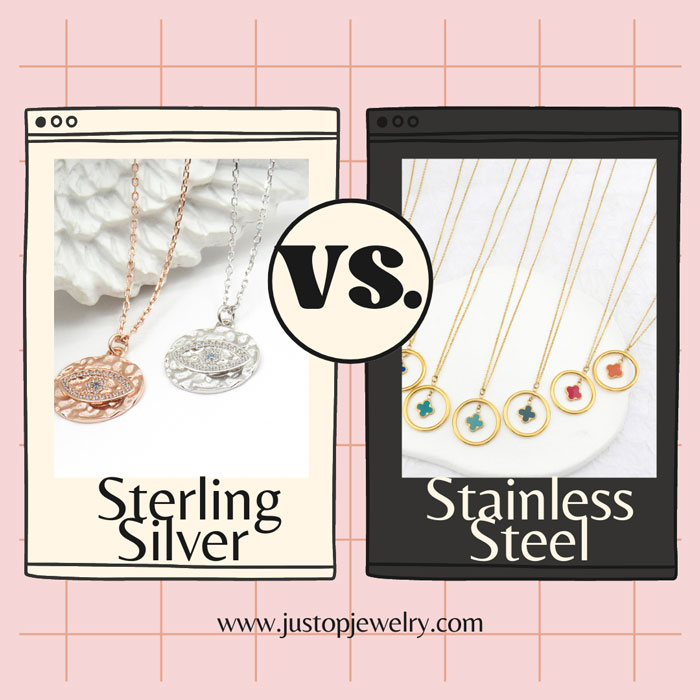When accessorizing with jewelry, the choice between sterling silver and stainless steel is a common dilemma. Both metals are renowned for their durability and aesthetic appeal but serve very different purposes depending on style preferences, usage, and budget. Today, we’ll dive deep into the nuances of these two popular materials, helping you decide which metal suits your lifestyle and fashion sense best.
What are Sterling Silver and Stainless Steel?
Sterling Silver: This is an alloy made up of 92.5% silver and 7.5% other metals, typically copper, which enhances its durability. Its hallmark is usually marked as .925, indicating its composition. Sterling silver is cherished for its lustrous finish and versatility in jewelry making.
Stainless Steel: This is a highly durable metal alloy, consisting mainly of iron, carbon, and chromium that provides corrosion resistance. It’s particularly valued for its strength and its shiny, often mirror-like appearance, which makes it a favorite in both fashion and industrial applications.
Comparison of Sterling Silver and Stainless Steel
Appearance: Both metals have a shiny, appealing finish. Sterling silver offers a brighter, more precious look due to its high silver content, making it popular in fine jewelry. Stainless steel has a more robust, modern appearance, making it ideal for both casual and formal wear.
Durability and Maintenance:
- Sterling Silver: While beautiful, sterling silver is softer and more prone to tarnishing and scratches. It requires regular polishing to maintain its luster.
- Stainless Steel: Known for its toughness, it is highly resistant to scratches, corrosion, and tarnishing, requiring minimal maintenance.
Cost: Sterling silver is generally more expensive than stainless steel due to its content of precious metal. Stainless steel offers a more budget-friendly alternative without compromising on the visual appeal.
Allergies and Sensitivity: Sterling silver is generally hypoallergenic, especially when nickel-free, but can still cause reactions in very sensitive individuals. Stainless steel, particularly 316L or surgical stainless steel, is also hypoallergenic and a great choice for those with metal allergies.

Pros and Cons
Sterling Silver
Pros:
- Lustrous and precious metal feel
- Greater malleability for intricate designs
- Higher resale value as a precious metal
Cons:
- More prone to tarnishing and scratches
- Requires more maintenance
- Generally more expensive
Stainless Steel
Pros:
- Extremely durable and scratch-resistant
- Low maintenance
- More affordable and great for daily wear
Cons:
- Heavier, which might not be comfortable for everyone
- Fewer traditional designs in high-fashion jewelry
- Not as valuable as sterling silver

Choosing between sterling silver and stainless steel often boils down to personal preference, lifestyle, and budget. If you value durability and affordability, stainless steel is a robust choice. However, if you prefer a more traditional and high-value material, sterling silver is unmatched. Each has its unique benefits and can make a significant impact on your jewelry collection.
For inquiries or to explore our exquisite collections of both sterling silver and stainless steel jewelry, feel free to reach out to us. Our team is eager to assist you in selecting the perfect pieces that reflect your style and meet your needs.
Frequently Asked Questions
Q: Can sterling silver be worn every day?
A: Yes, but it requires regular cleaning and may show wear over time due to its softer nature.
Q: Is stainless steel jewelry good for sensitive skin?
A: Yes, especially the 316L type, which is designed to be hypoallergenic and is commonly used for medical implants.
Q: Which is better for lasting quality, sterling silver or stainless steel?
A: For durability and resistance to wear and tear, stainless steel is superior. However, for a classic jewelry look and maintaining value, sterling silver is preferable.




